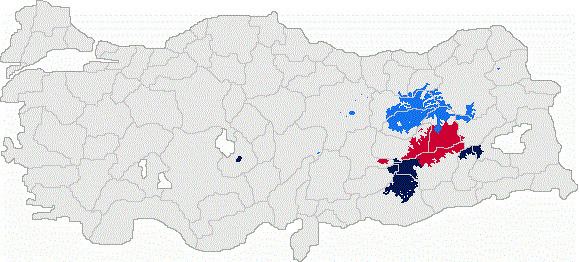Native to Anatolia Native speakers 1.6 million (1998) | ||
 | ||
Region Main in Tunceli, Bingöl, Erzincan, Sivas, Elazığ, Erzurum, Malatya Gümüşhane Province, Şanlıurfa Province, and Varto, Adıyaman Province; diasporic in Mutki, Sarız, Aksaray, and Taraz Language family Indo-EuropeanIndo-IranianIranianWesternNorthwestern IZaza–GoraniZaza | ||
Zaza language, also called Zazaki, Kirmanjki and Dimli, is an Indo-European language spoken primarily in eastern Turkey by the Zazas. The language is a part of the northwestern group of the Iranian section of the Indo-European family, and belongs to the Zaza–Gorani and Caspian dialect group. Zaza shares many features, structures, and vocabulary with Gorani. Zaza also has some similarities with Talyshi and other Caspian languages. According to Ethnologue (which cites [Paul 1998]), the number of speakers is between 1.5 and 2.5 million (including all dialects). According to Nevins, the number of Zaza speakers is between 2 and 4 million.
Contents
Classification
Zaza belongs to the Iranian branch of the Indo-European language family. From the point of view of the spoken language, its closest relatives are Mazandarani, Hewrami, Gilaki and other Caspian languages. However, the classification of Zaza has been an issue of political discussion. It is sometimes classified as a subdialect of Kurdish. The majority of Zaza-speakers in Turkey identify themselves as ethnic Kurds.
The US State Department "Background Note" lists the Zaza language as one of the major languages of Turkey, along with Turkish (official), Kurdish, Armenian, Greek, and Arabic. Linguists connect the word Dimli with the Daylamites in the Alborz Mountains near the shores of the Caspian Sea in Iran and believe that the Zazas have immigrated from Deylaman towards the west. Zaza shows many connections to the Iranian languages of the Caspian region, especially the Gilaki language.
The Zaza language shows similarities with Hewrami or Gorani, Shabaki and Bajelani. The Gorani, Bajelani, and Shabaki languages are spoken around the Iran-Iraq border; however, it is believed that speakers of these languages also migrated from Northern Iran to their present homelands. These languages are classified together in the Zaza–Gorani language group.
Dialects
There are three main Zaza dialects:
Its subdialects are:
Its subdialects are:
Its subdialects are:
Literature and broadcast programs
The first written statements in Zaza were compiled by the linguist Peter Lerch in 1850. Two other important documents are the religious writings of Ehmedê Xasî of 1899, and of Osman Efendîyo Babij (published in Damascus in 1933 by Celadet Bedir Khan); both of these works were written in the Arabic script.
The use of the Latin script to write Zaza became popular only in the diaspora in Sweden, France and Germany at the beginning of the 1980s. This was followed by the publication of magazines and books in Turkey, particularly in Istanbul. The efforts of Zaza intellectuals to advance the comprehensibility of their native language by using that alphabet helped the number of publications in Zaza multiply. This rediscovery of the native culture by Zaza intellectuals not only caused a renaissance of Zaza language and culture but it also triggered feelings among younger generations of Zazas (who, however, rarely speak Zaza as a mother tongue) in favor of this modern Western use of Zaza, rekindling their interest in their ancestral language.
The diaspora has also generated a limited amount of Zaza language broadcasting. Moreover, after restrictions were removed on local languages in Turkey during their move toward an eventual accession to the European Union, Turkish state-owned TRT Kurdî television launched several Zaza programs and a radio program on certain days.
Grammar
As with a number of other Indo-Iranian languages like Kurmanji and Sorani, Zaza features split ergativity in its morphology, demonstrating ergative marking in past and perfective contexts, and nominative-accusative alignment otherwise. Syntactically it is nominative-accusative.
Grammatical gender
Among all Western Iranian languages only Zaza and Kurmanji distinguish between masculine and feminine grammatical gender. Each noun belongs to one of those two genders. In order to correctly decline any noun and any modifier or other type of word affecting that noun, one must identify whether the noun is feminine or masculine. Most nouns have inherent gender. However, some nominal roots have variable gender, i.e. they may function as either masculine or feminine nouns. This distinguishes Zaza from many other Western Iranian languages that have lost this feature over time.
For example, the masculine preterite participle of the verb kerdene ("to make" or "to do") is kerde; the feminine preterite-participle is kerdiye. Both have the sense of the English "made" or "done". The grammatical gender of the preterite-participle would be determined by the grammatical gender of the noun representing the thing that was made or done.
The linguistic notion of grammatical gender is distinguished from the biological and social notion of gender, although they interact closely in many languages. Both grammatical and natural gender can have linguistic effects in a given language.
Vocabulary
Words in Zaza can be divided into five groups in respect to their origins. Most words in Zaza are Proto-Indo-European, Proto-Indo-Iranian and Proto-Iranian in origin. The fourth group consists of words that developed when Zaza speakers divided from the Proto-Iranian language. The fifth group consists of loan words. Loan words in Zaza are chiefly from Arabic and Persian.
Alphabet
The Zazaki alphabet contains 31 letters:
Notes
